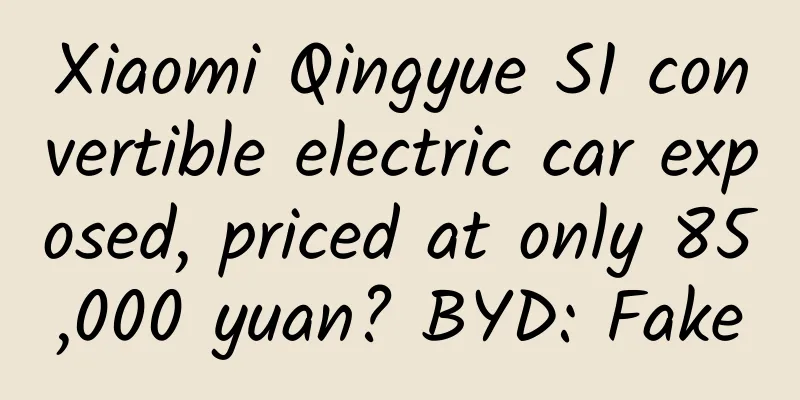What will happen to the new energy vehicle market if the huge subsidies disappear?

|
Last year, one out of every two electric cars sold worldwide was purchased by a Chinese owner. From January to August this year, my country's sales of new energy vehicles hit a new high, up 88% from the same period last year. However, behind the prosperity, many experts and scholars are calling for "calmness." Because the rapid development of my country's electric vehicle industry is due to two-wheel drive, one wheel is the market, and the other wheel is policy and subsidies. In fact, in the eyes of many knowledgeable people, the wheel of subsidies seems to be slightly larger than the market. When the wheels on both sides are of different sizes and the industry itself is running at high speed, if no measures are taken, a rollover tragedy will soon occur. Fortunately, the relevant national departments have realized the existence of the problem and decisively adopted a new policy to reduce subsidies for new energy vehicles. In June this year, the new policy has cancelled subsidies for new energy vehicles with low mileage and set higher requirements for subsidy acquisition conditions. The amount of subsidies received by most car companies has been greatly reduced compared with previous years. The subsidy policy has actually begun to decline. There are also reports that after 2020, my country's market subsidies for new energy vehicles may be completely cancelled. China's new energy vehicle industry is extremely dependent on subsidies. If the subsidies are cancelled, is my country's new energy vehicle industry ready? And where will it go? Breaking down electric vehicle range anxiety is the top priority The overall price of new energy vehicles is relatively high now. The manufacturer's suggested retail price of any A-class car is around 200,000 yuan, and the price of a mini car can easily exceed 100,000 yuan. If it were not for policies and subsidies, the sales of new energy vehicles would never be so impressive. How to make consumers accept and buy new energy vehicles from the bottom of their hearts and let the product itself speak for itself. This is the biggest problem facing the entire new energy vehicle industry. Undoubtedly, the first thing to be solved is the user's range anxiety. Compared with fuel vehicles, the biggest shortcoming of new energy vehicles is the low range. After all, the most important function of a car is travel and transportation, and range is the most critical performance, which is also the core interest of new energy vehicle consumers that cannot be avoided and must be faced directly. The key to improving the range of electric vehicles lies in improving the energy density of batteries. At present, the mainstream battery technology is ternary lithium batteries, and solid-state batteries with higher energy density are expected to become the next generation of battery technology in the near future. However, although there is still room for improvement in the energy density of power batteries, even in theory, it is difficult to surpass or even catch up with the efficiency of fuel vehicles. Of course, battery density is not the only variable that affects the range of electric vehicles. Improvements in the efficiency of the electric motor and the level of electronic control can also increase the range of electric vehicles. As the saying goes, a journey of a thousand miles begins with a single step. When the energy efficiency of the entire vehicle is improved, the range will also be improved accordingly. In addition to the big three electrics (battery, motor, and electronic control), the small three electrics (electric brake, electric steering, and electric air conditioning) technology also has room for development. In addition, the trend of lightweighting of automobiles will also contribute to the improvement of the range. Relevant research shows that for every 10% reduction in the weight of an electric vehicle, the range will increase by 6%. Improve the infrastructure of charging facilities If charging facilities are well built, the anxiety about the range of electric vehicles will be greatly alleviated. There is no technical difficulty in building charging facilities, but it is more of a matter of funding and operation. Data from the China Charging Alliance shows that from August 2017 to July 2018, China added an average of 7,841 public charging piles per month. Although the growth rate is already very impressive, it is still a huge shortfall. Imagine if charging facilities are as dense as gas stations in the future, it will be common for electric trucks to travel long distances across provinces. With China's strong infrastructure capabilities, I believe this day will not be too far away. Haven't Tesla trucks in the United States been on the road for a long time? Challenging fuel vehicles, electrification is not the only one fighting China's new energy vehicle industry is leading the global trend and is transforming towards intelligence, electrification, networking and sharing. Compared with the WYSIWYG of electrification, the changes brought about by intelligence, networking and sharing to the automotive industry are more far-reaching. Smart cars mainly involve autonomous driving and smart cockpits. Autonomous driving below level L3 can make driving easier. For example, in highway driving scenarios, the road conditions are very simple and drivers can easily feel bored and tired. At this time, L3 autonomous driving can replace the control of the car. Autonomous driving at level L4 and above can completely liberate humans from driving work. In application scenarios such as commercial vehicles, public vehicles and special vehicles, labor costs can be greatly reduced. Smart cockpits can make cars understand car owners and passengers better. The intelligent interaction allows people to communicate through voice, gestures, expressions and even eye contact, providing a more comfortable and convenient riding experience for people in the car. Smart cockpits can make cars the next mobile smart platform. Relying on the Internet of Vehicles, cars can connect to a variety of services, allowing cars to evolve into new functions such as mobile offices and mobile shopping carts. The Internet of Vehicles can open up communications between vehicles and other vehicles, pedestrians, road infrastructure, and the cloud, thereby serving autonomous driving and in-vehicle intelligent platforms. By establishing connections between vehicles and the outside world, the Internet of Vehicles can share information, thereby coordinating traffic and improving efficiency. The development of automobile intelligence means that the degree of automobile electrification will become higher and higher. However, fuel vehicles are not friendly to electronic equipment. The power output of fuel vehicles will release a lot of heat and vibration waves, which has a great impact on electronic components and semiconductors. The electric energy used by fuel vehicles needs to be converted twice, which not only causes energy loss, but also causes power transmission fluctuations, which is not conducive to providing a stable working environment for electronic components. With the gradual improvement of automobile electronics and intelligence, in the automotive aftermarket, electronic unit failures of fuel vehicles have replaced mechanical failures as the most common type of failure. Pure electric vehicles are the best carriers of automotive intelligence. Batteries have independent cooling systems; motors are much better than internal combustion engines in terms of balance. Moreover, batteries directly supply power, so there is no problem of unstable power transmission. The good compatibility of pure electric vehicles and smart applications provides them with a broad future. Electric vehicles are also the best platform for autonomous driving. First, the control part of autonomous driving needs to electrify related components. In addition, the motor has an extremely fast reaction speed, and the electrical signal can be directly converted into a mechanical signal, making it easier for the ECU (onboard computer) to control the mechanical structure. Autonomous driving technology is difficult to implement and has very high safety requirements. The easy-to-control characteristics of motors can reduce the difficulty of autonomous driving technology and are also better in ensuring safety. Although some fuel vehicles are already equipped with partial autonomous driving functions, the vast majority of autonomous driving technology research and development is currently combined with electric vehicles. From the perspective of car sharing, electric vehicles also have better development prospects than fuel vehicles. For shared car and taxi companies, due to unified management and mostly short-distance transportation within the city, the endurance of electric vehicles is no longer a problem. Electric vehicles have cost advantages over fuel vehicles in terms of car maintenance and repair, and electricity is cheaper than fuel. In the future, smart networking, autonomous driving, and shared cars will all be based on new energy vehicles. Electric vehicles will not fight independently, but will challenge fuel vehicles with the help of the entire industry ecosystem. Electric vehicles are related to national energy security In addition to promoting the upgrading of the automobile industry, China strongly supports the development of new energy vehicles because energy security is also a very important consideration. China's dependence on foreign oil is as high as 70%. China has more than 300 million fuel vehicles, which consume a large amount of oil resources every year. Energy security is not only an economic issue, but also a national security issue. Replacing fuel vehicles with electric vehicles is an important means to ensure energy security. Even if all subsidies are cancelled in 2020, the dual-credit policy will continue to work. my country will not completely give up its support for the new energy vehicle industry. As governments of various countries announce the timetable for the ban on the sale of fuel vehicles and some car companies begin to announce the deadline for stopping the sale of fuel vehicles, by then, even if electric vehicles are still inferior to fuel vehicles in terms of battery life, the market will have no other choice. Although electric vehicles still have some shortcomings, with the advancement of technology, the advancement of infrastructure, the strong support of the country and the gradual maturity of the entire industry ecosystem, it is only a matter of time before domestic electric vehicles replace fuel vehicles and take the leading position. As a winner of Toutiao's Qingyun Plan and Baijiahao's Bai+ Plan, the 2019 Baidu Digital Author of the Year, the Baijiahao's Most Popular Author in the Technology Field, the 2019 Sogou Technology and Culture Author, and the 2021 Baijiahao Quarterly Influential Creator, he has won many awards, including the 2013 Sohu Best Industry Media Person, the 2015 China New Media Entrepreneurship Competition Beijing Third Place, the 2015 Guangmang Experience Award, the 2015 China New Media Entrepreneurship Competition Finals Third Place, and the 2018 Baidu Dynamic Annual Powerful Celebrity. |
Recommend
A case study tells you the difference between a master copywriter and a novice copywriter
In August last year, I finally learned how to use...
A long article to understand all the tricks of the "100,000+" title
This is an era of "information miniaturizati...
Three Squirrels' business strategy and marketing logic
When it comes to the national snack internet cele...
The first of this year! The Central Meteorological Observatory issued a red warning for high temperatures
Recently, high temperatures have continued in sou...
Isn’t cholera a Class A infectious disease? Why are the cases at Wuhan University not dangerous?
For the same cholera, some strains may be just &q...
Why Amazon has become the most innovative company
Imagine: What would the ideal neighborhood look l...
The temperature drops suddenly, rain and snow come, how powerful is this all-round cold air?
From January 11 to 15, an all-around cold front w...
A brief analysis of precise audience targeting in Internet advertising!
With the development of Internet advertising tech...
[Creative Cultivation Program] How dirty are your mobile phone, remote control, and bed sheets? They are like a garbage dump!
Author: Shao Menglong Reviewer: Ma Zansong, Deput...
Review! Alipay's promotional tactics of sending 1 billion red envelopes
After the amazing copywriting of Alipay red envel...
Nanchang SEO Training: How to write a high-quality SEO article? What aspects can be improved?
Many webmasters believe that the website content ...
Enoki mushrooms, Chinese cabbage, etc. are all formaldehyde vegetables and cannot be eaten?
Rumor: "Enoki mushrooms, Chinese cabbage, et...
Baidu and Volvo jointly build L4 self-driving car Apollo to practice "safety" as its mission
An era of autonomous driving that is accelerating...
Free hardware no longer explores the root cause of the price increase of domestic mobile phones
In recent years, the domestic mobile phone indust...
How to become the most popular person on Douyin live streaming?
It is becoming increasingly difficult to live str...









